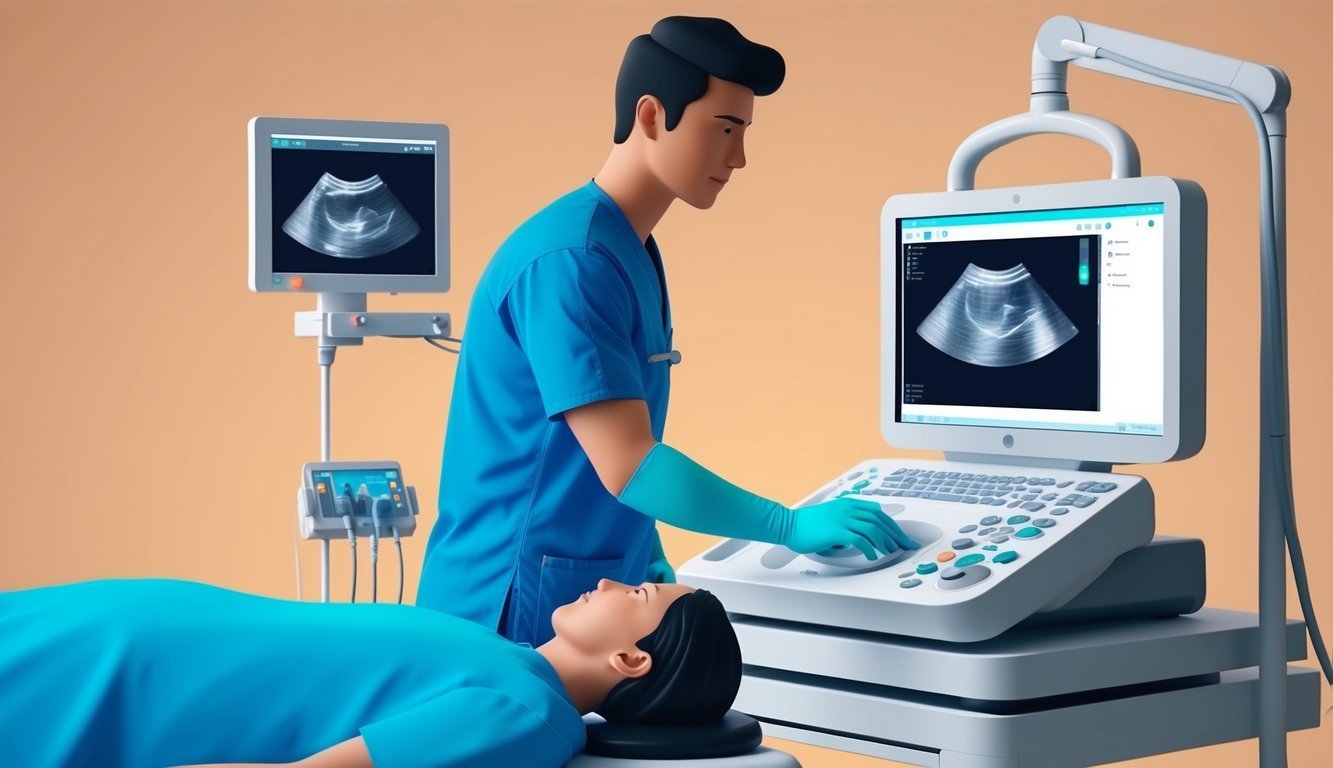Embarking on a career as an ultrasound technician offers the opportunity to combine technology with patient care.
Typically, you need to complete an accredited program to become an ultrasound technician.
These programs may include a certificate, associate’s, or bachelor’s degree.
After that, you need to obtain certification.
This path not only opens doors to a rewarding job but also places you in a vital role within the healthcare system.
As you consider this career, understanding the educational and certification requirements is essential.
Many programs include both classroom learning and hands-on clinical experience, equipping you with the skills needed to excel in this field.
Resources such as Nurse.org and Indeed can provide detailed guidance and job market insights that help you navigate your journey.
Additionally, exploring certification options through organizations like the ARDMS can validate your expertise and enhance your employability.
As the demand for skilled ultrasound technicians continues to grow, taking these steps can position you for a successful career in a dynamic healthcare environment.
Understanding the Role of an Ultrasound Technician
As an aspiring ultrasound technician, it’s essential to grasp the comprehensive roles and responsibilities involved in medical sonography.
This field focuses primarily on using sound waves for diagnostic imaging, and encompasses various specialties in different healthcare environments.
The Basics of Medical Sonography
Medical sonography involves creating images of the body’s internal structures using sound waves.
As a diagnostic medical sonographer, you will operate ultrasound equipment, capturing images that aid physicians in diagnosing medical conditions.
Your role includes preparing patients for procedures, providing instructions, and ensuring their comfort.
You must also pay attention to detail, as you will need to accurately assess images for quality and completeness.
You’ll also maintain equipment and adhere to safety protocols.
Understanding anatomy and physiology is vital, enabling you to recognize structures and potential abnormalities.
Different Specialties of Sonographers
Ultrasound technicians can specialize in various areas, enhancing their expertise and career opportunities.
Common specialties include:
| Specialty | Description |
|---|---|
| Obstetric Sonography | Focuses on imaging during pregnancy to monitor fetal development. |
| Abdominal Sonography | Involves imaging of organs such as the liver, kidneys, and pancreas. |
| Cardiac Sonography | Specializes in evaluating heart structures and functions through echocardiograms. |
| Vascular Sonography | Assesses blood flow and vascular conditions using Doppler ultrasound. |
Each specialty requires specific training and certification, so you should consider what aligns best with your interests and career goals.
Workplaces for Ultrasound Technicians
Ultrasound technicians are employed in various settings, which can affect your daily tasks and experiences.
Common workplaces include:
- Hospitals: Often offer diverse opportunities to work with various patient populations.
- Outpatient Clinics: Focus on specialized care and may provide structured work hours.
- Diagnostic Imaging Centers: Concentrate solely on imaging services, fostering a collaborative environment.
- Research Facilities: Involves advanced imaging techniques and contributions to scientific studies.
Each setting provides unique challenges and learning opportunities, making it essential to choose a workplace that fits your career aspirations and work style.
For further insights, consider exploring resources like Nurse.org or Sonography Technician Schools.
Educational Pathways
Becoming an ultrasound technician involves navigating specific educational pathways that equip you with the necessary skills and knowledge.
You can choose from various degree options and accredited programs, each offering unique curricula to prepare you for a career in this vital field.
Sonography Degree Options
To pursue a career in ultrasound technology, you typically have two primary degree options: an associate degree and a bachelor’s degree.
| Degree Type | Duration | Focus |
|---|---|---|
| Associate Degree | 2 years | Basic sonography skills and clinical practice |
| Bachelor’s Degree | 4 years | Advanced studies, specialized training |
An associate degree usually suffices for entry-level positions, allowing you to complete an ultrasound technician program in a shorter time.
In contrast, a bachelor’s degree delves deeper into advanced topics, making it suitable for those aiming for specialized roles or leadership positions within the healthcare field.
Accredited Sonography Programs
Selecting an accredited sonography program is crucial.
Accreditation ensures that the program meets industry standards and adequately prepares you for certification.
When researching programs, consider:
- Program Length: Most take between 12 to 24 months.
- Clinical Internship: Look for programs with extensive hands-on clinical experiences.
- Certification Preparation: Ensure the program prepares you for certification exams.
It’s advisable to check for programs accredited by the Commission on Accreditation of Allied Health Education Programs (CAAHEP).
Accreditations might impact your employment opportunities, as many employers prefer hiring graduates from accredited institutions.
Undergraduate Curriculum Overview
An ultrasound technician program combines theoretical knowledge with practical skills.
The typical curriculum includes essential subjects such as:
- Anatomy and Physiology: Understanding the human body structure and function.
- Medical Terminology: Learning the language used in healthcare settings.
- Ultrasound Physics: Grasping the principles of sound waves and imaging techniques.
Additionally, most programs necessitate a clinical internship, giving you real-world experience in healthcare settings.
This hands-on training is invaluable for applying classroom learnings to practical scenarios.
Completing a robust curriculum prepares you for the challenges of a career in sonography, making you a competitive candidate in the job market.
Certification and Credentials
Obtaining the necessary certifications and credentials is essential to practice as an ultrasound technician.
This section highlights the key organizations that offer certification, the types of sonography certifications available, and the importance of continuing education for career advancement.
Certifying Organizations
Several organizations offer certifications for ultrasound technicians.
The most prominent are:
-
American Registry for Diagnostic Medical Sonography (ARDMS): One of the leading certifying bodies, the ARDMS provides the Registered Diagnostic Medical Sonographer (RDMS) credential. This certification showcases your expertise in sonography.
-
American Registry of Radiologic Technologists (ARRT): ARRT offers various imaging certifications, including some related to ultrasound technology. This organization emphasizes the importance of ethical practice and continuous professional development.
-
Cardiovascular Credentialing International (CCI): This organization focuses on cardiovascular sonographers and offers credentials such as the Registered Diagnostic Cardiac Sonographer (RDCS).
Types of Sonography Certifications
Certifications vary depending on your area of specialization.
Here are some key certifications you can pursue:
-
Registered Diagnostic Medical Sonographer (RDMS): This certification from ARDMS is essential for general sonography practice.
-
Registered Diagnostic Cardiac Sonographer (RDCS): Focuses on the cardiac aspects of ultrasound, validating your skill in echocardiography.
-
Registered Vascular Technologist (RVT): Also provided by ARDMS, this certification is geared towards vascular ultrasound specialists.
-
Additional Certifications: Depending on your specialization, you may consider pursuing related certifications from CCI or ARRT to enhance your credentials.
Continuing Education and Advancement
Continuing education is vital to maintain your credentials and stay updated on advancements in ultrasound technology.
Here are important aspects to consider:
-
CEU Requirements: Most certifying organizations, including ARDMS and ARRT, require you to complete a specific number of Continuing Education Units (CEUs) every few years to renew your certification.
-
Workshops and Training Programs: Engaging in workshops, online courses, or conferences can help fulfill CEU requirements while expanding your professional knowledge.
-
Career Advancement: Advanced certifications or specializations can open doors to higher-paying positions and roles with increased responsibilities. Keeping your skills current will position you for long-term success in the field.
Consider exploring the certification details on the ARDMS website for additional guidance on how to navigate the certification process effectively.
Hands-On Experience and Clinical Practice
Gaining hands-on experience is crucial in becoming an ultrasound technician.
Clinical practice provides the practical skills and confidence needed to perform diagnostic imaging.
Engaging in real-life scenarios under supervision enhances learning and prepares you for professional challenges.
Importance of Clinical Practicum
The clinical practicum is essential for your development as a medical sonographer.
During this phase, you will apply theories learned in sonography training to actual patient care.
In a typical clinical internship, you will:
- Interact with patients to improve your communication skills.
- Perform ultrasound procedures under the guidance of experienced healthcare professionals.
- Learn to operate ultrasound equipment effectively and safely.
This hands-on experience allows you to troubleshoot equipment, assess images, and make accurate diagnoses.
Completing a robust clinical practicum prepares you for real-world challenges and enhances your employability upon graduation.
Clinical Partnerships
Many educational programs establish partnerships with healthcare facilities to facilitate clinical experience.
These partnerships are vital for your success, providing access to a range of clinical settings where you can gain valuable insights.
Through these partnerships, you may benefit from:
- Diverse settings: Exposure to various specialties such as obstetrics, cardiology, and emergency medicine.
- Networking opportunities: Connect with seasoned medical sonographers and healthcare professionals who can offer career guidance.
- Real-world applications: Gain insights into best practices, patient management, and the operational aspects of healthcare.
Finding a program with strong clinical partnerships can significantly enhance your learning experience and career prospects.
Career Prospects and Industry Outlook

The career prospects for ultrasound technicians are promising, with growth expected in various healthcare settings.
Understanding job opportunities and salary potential is essential for anyone considering this profession.
Job Opportunities and Growth
The demand for ultrasound technicians is increasing due to advancements in medical imaging technology and a growing aging population.
According to the U.S. Bureau of Labor Statistics, employment in this field is projected to grow by 26% from 2021 to 2031.
This growth rate is much faster than the average for all occupations.
Job opportunities are prevalent in different settings, including:
- Hospitals
- Outpatient care centers
- Physician offices
Each of these settings offers unique opportunities for specialization.
Those with certifications in specific areas of sonography may find even greater prospects.
Salaries and Benefits
The salary for ultrasound technicians varies based on experience, location, and work environment.
As of May 2023, diagnostic medical sonographers earned a median annual wage of approximately $84,470.
Cardiovascular technologists also earned a median salary of $66,170.
Here’s a breakdown of average salaries by setting:
| Work Environment | Average Salary |
|---|---|
| Hospitals | $83,000 |
| Outpatient care centers | $86,000 |
| Physician offices | $79,500 |
Technicians also receive benefits such as health insurance, retirement plans, and paid time off, enhancing the overall compensation package.

